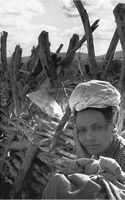
|
 |
Barren
Lives
Vidas Secas
|
BRAZIL
/ 1963 / Portuguese / B&W / 35mm (1: 1.33) / 105 min
Director, Screenplay: Nelson Pereira dos Santos
Based on the novel by: Garciliano Ramos
Photography: Jose Roza, Luiz Carlos Barreto
Editing: Rafael Justo Valverde
Sound: Geraldo Rose
Producers: Herbert Richers, Danilo Trelles, Luiz Carlos Baretto
Cast: Atila Iorio, Maria Ribeiro
Source: Cultural Department of The Ministry of Foreign Relations,
BRAZIL

 |
|
Nelson
Pereira dos Santos

Film director. Born 1928 in São Paulo. Studied law and journalism,
but his love of cinema led him to travel to Paris where he attended
IDHEC (now known as FEMIS), the French national film school. Returning
to his hometown he directed two independently-produced shorts, then
moved to Rio de Janeiro where he entered the film industry as an assistant
director. In 1955, directed his first feature, Rio 40 Degrees
("Rio Quaranta Graus"), shot on city streets using people
who were not professional actors. In the Brazilian Cinema Nuovo movement
of the 1960s and 1970s the idea was to create a popular national cinema
free of foreign influence. With the release of Barren Lives
("Vidas Secas," 1962), he became a leading filmmaker in
that cause and was often referred to as the conscience of Cinema Nuovo.
His filmography includes How Tasty Was My Little Frenchman ("Como
Era Gostoso o Meu Francês," 1971), Memoirs of Prison
("Momórias do Cárcere," 1984), The Third Bank River
("A Terceira margem do Rio," 1994), and War and Liberty
- Castro Alves in São Paulo ("Guerra e Liberdade
- Castro Alves en São Paulo," 1998). |
"This is not only a faithful cinematic adaptation of the immortal
masterpiece of Brazilian literature. Most of all it is a testimony
to the dramatic social reality of our times, about the misery that
pushes 27 million Northeasterners into slavery." This statement
at the beginning of the film may be the best introduction to one of
the first masterpieces of Brazilian Cinema Nuovo. Using non-professional
actors and filming in real locations may be techniques that are common
new wave filmmaking in other parts of the world, but Pereira Dos Santos
did not developed these techniques to achieve an agility of cinema.
His camera is put at such an angle that, once you see its composition
you just cannot imagine moving it or looking for a different set-up.
If one may call Vidas Secas the Brazilian Grapes of Wrath,
then the true epic power that the film reveals in this family living
in misery should be compared with some of the best John Ford films.
Joris
Ivens, - Juror's statement
I met Joris Ivens at the International Filmmakers Meeting, held in
Paris in 1956.
It was for me, then directing my first film, an exciting event. I
faced the author of Rain (1929), Borinage (1934), and
The Spanish Earth (1937), all remarkable film realizations
that enhanced my entire generation in the late '40s.
Since then and until his death, we had other occasions to be together.
Of those days, I still cherish his special lessons.
The most important of all, about light, was kindly shared with me
during a promenade along the Seine on a spring day. What he said clearly
demonstrated his ability as a photographer, almost a lover's confession,
referring to light as the main actor in a film. It is up to the director,
he said, to catch the light, always changing, always present, to better
know men and things. He suggested that one must be familiar with light
on all ocassions, to be intimate with it, in order to recreate it
later in an artistic way.
Many Thanks, Joris.
|
  |
|
before  next next |
COPYRIGHT:Yamagata International Documentary Film Festival Organizing Committee |